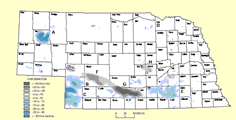Natural Resources, School of
Date of this Version
2022
Citation
Joeckel, R. M., Korus, J. T., Turk, J. K., Arps, C. C., Arps, N. V., Howard, L. M. (2022). Strange stones of Skull Creek: Basalt glacial erratics and omars in eastern Nebraska. Great Plains Research, 32, 1-20.
Abstract
We describe unusual stream- reworked glacially transported rocks (erratics) from a locality 50 km east of the limit of all pre- Illinoian (pre- 190 ka) Pleistocene glaciations in the central USA. Almost all these erratics consist of the igneous rock basalt, and of those, the vast majority have at least one fl at, smooth face. Some have two or more such faces that meet at obtuse angles along one or more well- defi ned, straight edges. We attribute these features, as well as laminations, plumose marks, and other features, to columnar jointing in ancient lava fl ows and shallow intrusions. Th e most likely source of these erratics is the Lake Superior region. Aft er the Laurentide Ice Sheet deposited them, the erratics experienced at least one episode of erosion and deposition in local stream sediments as the regional landscape evolved during the Middle Pleistocene to Holocene times. Before it found its way into Skull Creek, one of the basalt erratics was polished and reshaped as a ventifact by sediment- laden Pleistocene winds as it lay exposed on an ancient land surface. We also found four examples of omars: very distinctive erratics that eroded from outcrops in Hudson Bay and transported 2,100 km into the study area.
Included in
Geology Commons, Geomorphology Commons, Hydrology Commons, Paleontology Commons, Sedimentology Commons, Soil Science Commons, Stratigraphy Commons


Comments
Copyright © 2022 by the Center for Great Plains Studies, University of Nebraska–Lincoln